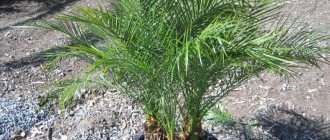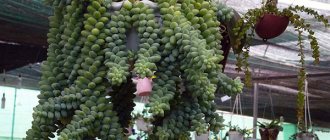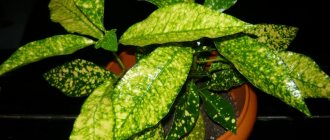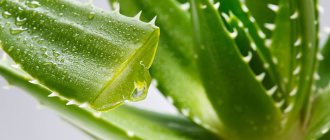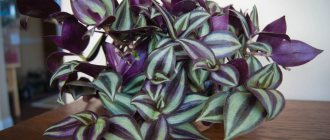general characteristics
Crotona flowers have erect stems of medium length. For a detailed acquaintance with a representative of the Euphorbiaceae family, the following description of the flower is better suited:
- Large, with a shiny surface, rich green in color with abundant splashes of yellow, bronze, and scarlet.
- Depending on the variety, the edge of the leaf blade may be wavy, smooth, or slightly jagged.
- The shape of the leaf blade can be very different: from round to oblong in the form of a lancet.
- Young leaves have a paler shade, which becomes richer as the leaf matures.
- During active flowering, axillary tassels are formed on the branches, each of which consists of several inflorescences of different colors.
Croton leaves grow upward, moving away from the stem at an acute angle, due to which the plant acquires a compact and original appearance.
Types and varieties
In indoor culture, variegated croton is grown, the distinctive feature of which is the ability to change the color and shape of the leaves depending on living conditions. It was this quality that made the species the basis for experiments in selection, which culminated in the development of many varieties, hybrid forms and varieties.
In the photo: Croton variegated (variegatum)
Croton variegated (variegatum)
grows in nature in Pakistan and China, sometimes reaching three meters in height. The leaves are short-petioled. The color of the leaves is green and brown. This species has several forms, differing in the shape of the leaves: adventitious, lobed, flat-leaved and decorated, which served as the basis for the development of many remarkable varieties.
Varieties:
- Mrs. Eyeston - grows as a large tree or bush with leaves brightly colored dark burgundy with bright pink spots, although there is a variety with golden leaves with almost black fragments and a variety in yellow-pink tones;
- Petra - in nature it grows to a height of up to four meters, branches well, the shape of the leaves is oval, lobed or pointed, the color is dark green with a bright yellow edging and contrasting veins and specks of the same color;
- Black Prince - its wide oval flat leaves of black-green color with many yellow, red and orange spots look very exotic;
- Disraeli has lobed leaves, colored green at the top with yellow veins and specks, and brick-brown at the bottom;
- Excellent is distinguished primarily by the shape of the leaves, reminiscent of oak leaves; the color of the lower part of the leaf is red-burgundy, and the upper part is yellow-green.
The following varieties of variegated croton are also of interest: mollucian, minus, genuine, oval-leaved, tortoiseshell, curly and spiral. But no matter what type you purchase, you can believe that it will become the most noticeable decoration in your interior.
Lighting requirements
The bright colors of croton leaves are the result of pigments produced through photosynthesis. This plant needs plenty of sunlight. In this case, direct sunlight can damage the surface of the sheet and cause burns.
To prevent such conditions, you should place a flower pot on windows with diffused light (in winter - the south side of the house, the rest of the time - the western and eastern sides). In summer, you can take the pot outside or onto the balcony in a shaded place.
Description
It is an evergreen shrub that grows up to 70 cm. The leaves are hard, smooth and shiny. Codiaum blooms very rarely. What makes it attractive as a house plant? With its amazing coloring.
If its stem is woody, then the leaves have a variety of colors: green, orange, yellow, red and even dark purple. At the same time, they are covered with bright scarlet or green veins. Some species amaze with their amazing bronze and silver patterns. In addition, croton differs in varieties, so you can easily find a plant that suits your taste.
Codiaum excelent is especially unusual. It grows very beautiful leaves, which are called oak leaves. They are rich, bright colors: from green to red, and in addition they are decorated with contrasting patterns.
Organization of watering
There are a few simple care rules that will help keep the plant healthy for a long time. How to water a flower correctly:
- Croton loves high air humidity, and therefore the leaves must be periodically wiped with a damp cloth. Regular spraying of the bush with a spray bottle will help ensure the proper level of humidity.
- In summer, an additional summer shower will be required.
- Watering is carried out on demand, as the soil in the pot partially dries. Do not allow water to stagnate in the flower tub, which can cause root rot.
For irrigation, use only settled water, the temperature of which is above the room range. Hypothermia of the roots when using cold water can lead to a decrease in immunity and the rapid occurrence of infectious diseases.
Diseases and pests
Croton is pleasantly disease resistant. What appears to be a disease at first glance is usually the result of neglect.
- Leaf falling: the plant is located in too dark a place.
- Dropping leaves from below: the plant is in a draft.
- Color Fading: Light intensity is well below 75 percent, so repositioning is recommended.
- Drying leaves or brown tips: Humidity too low. Requires daily spraying with settled water.
If the colorful ornamental leaves gradually turn green, this is neither a disease nor a care error. Colorful hybrids tend to adopt the green foliage of their wild species. You can stop this process by cutting off the green leaves one by one. Please make sure in advance that the landscaping is not due to the location being too dark.
Pests
Poisonous milky sap does not protect croton from pests. Curled leaves indicate an infestation of sucking insects such as aphids and mealybugs. Affected plants must be immediately isolated and treated.
In the early stages of infection, spray the bush with a powerful stream of water. Aphids are effectively treated with a mixture of 1 liter of water and 1 tablespoon of mild soap. Stubborn mealybugs should be removed using a rag soaked in an alcohol solution.
If necessary, use insecticide chemicals to control pests, following the instructions for use.
Plant nutrition
Growing Croton at home requires mandatory fertilization of the soil in the flower pot. The presence of bright and large leaves, rapid growth of the bush and flowering require constant replenishment of nutrients in the soil.
Active fertilizing is used from early spring to late autumn. Complex mineral fertilizers can be found in specialized floriculture supply stores.
Features of cultivation
The indoor croton flower is a bush with leathery leaves of various shapes: asymmetrical, oblong-lanceolate, pointed or blunt-pointed, entire-edged, three-lobed, notched, broadly ovate, etc. Young leaves, usually lighter shades of yellow-green, become richer green and burgundy colors over time, so your indoor croton flower is colored like an elegant autumn forest. A common feature for leaves of all varieties and varieties is pronounced venation. The flowering of croton will not cause you any delight, since it is a pendulous axillary racemose inflorescence of inconspicuous cream flowers.
In the photo: Croton growing outdoors
The home flower croton has earned the reputation of one of the most capricious plants. What are the features of caring for croton?
- Croton juice is poisonous. It causes diarrhea, vomiting, and contact dermatitis, so all work with croton should be done with gloves.
- Croton at home requires not only spraying the leaves with a spray bottle, but also wiping them with a damp sponge. In the summer, give your croton a warm shower every month.
- Croton does not tolerate watering with cold water and drafts!
- Sometimes at the beginning of the growing season, croton leaves take on strange shapes. No one knows how this is explained, but croton has a high degree of mutation, which is why it has become possible to develop many varieties and hybrid forms of this plant, and they differ only in how the leaf of one or another variety of croton looks.
- The inconspicuous flowering of croton takes a lot of energy from the plant, and if you are not going to engage in breeding experiments, it is better to remove flower buds or peduncles immediately.
Regular bush pruning
The spectacular crown of croton requires regular pruning. It is this measure that allows you to maintain a neat and compact bush. Pruning is carried out according to the following scheme:
- The first pinching is carried out when the croton reaches a height of 15 cm.
- Subsequent pruning will be done as the bush reaches a height of 20 cm.
- Young flower stalks and buds are also removed, which take a lot of strength and energy from the bush.
The cut areas are immediately treated with charcoal or sulfur powder. Such indoor care is aimed at preventing the development of infectious diseases caused by viruses, bacteria and fungi.
Croton transplant rules
The Croton houseplant must be replanted once every 6 months. Older representatives are transplanted once every 2 years. Rules for optimal transplantation:
- The new pot should not differ much in width from the old container.
- Due to the high sensitivity of croton to infectious diseases, the pot should first be washed and doused with boiling water to destroy pests, spores, and bacteria.
- A drainage layer in the form of expanded clay is laid on the bottom of the pot. Such drainage will retain moisture in the required amount, without creating conditions for stagnation of water.
- A mixture for planting croton is placed on top of the drainage layer. Its composition must necessarily include peat, sand, turf and leaf humus.
- Transplantation is carried out using the transshipment method.
The plant is carefully removed from the old pot along with a lump of earth. The roots are carefully examined for the presence of pests, signs of damage and diseases. Remove damaged roots. At the same time, it is important to try not to destroy the earthen lump on the roots of the croton. Place the plant in a new container and sprinkle with soil.
Caring for codiaum at home
According to experienced flower growers, caring for codiaum is not as difficult as it might seem at first glance. This shade-tolerant plant will not cause any trouble even for an inexperienced gardener. Next, we will look at all the nuances of care in more detail.
Lighting
It is recommended to place a pot with this flower on windowsills facing the eastern or western part of the world. It is not recommended to place such a plant on southern windows, because intense sunlight in this place can cause burns to its leaves.
Important! If there is a lack of sunny color, the leaves of the crop will lose their variegated color. The optimal lighting option is diffused light.
Temperature and humidity conditions
The temperature in the room when growing croton in the summer should be stable, corresponding to 20-25 degrees.
With the arrival of winter, the temperature can drop to 18 degrees, but not lower.
The culture does not tolerate exposure to drafts; codiaum sheds its leaves from cold air , so keep the flowerpot with the plant away from open windows and doors.
Despite the fact that Croton is a leaf succulent, it requires a humidity level of 70-75% . Such indicators can be achieved by regularly moistening the leaves of the plant. In addition, the leaves should be constantly wiped with a damp soft cloth or napkin . To increase the humidity level, place a container with water and expanded clay or pebbles next to the pot.
Watering
The indoor codiaum flower is watered as the top layer of soil dries. The amount of irrigation liquid should be moderate; if it is over-moistened, the crop will begin to shed its leaves.
To prevent stagnation of water, drainage from expanded clay is arranged at the bottom of the flowerpot. Watering the plant must be done with soft or pre-boiled water. You can also use pre-settled tap liquid.
This video talks about the Euphorbiaceae family and how to care for plants of this family, in particular croton:
Top dressing
During the growing season in spring and autumn, the plant must receive additional nutrients from the soil. Feeding is carried out every two weeks . To enrich the soil with useful substances, special water-soluble store-bought fertilizers are used. The working solution is prepared in accordance with the instructions on the package.
Transfer
A few days after purchase, indoor plants need to be transplanted into a new container.
During this procedure, you need to thoroughly clean the roots of the plant from the old nutrient substrate.
A new flowerpot is selected several centimeters larger in diameter than the transport container. Expanded clay drainage is placed at the bottom of the pot and special soil is poured on the base of leaf, turf and humus soil with the addition of sand and peat.
Note! Young crotons are replanted annually in the spring. Old plants are moved to new larger containers as the root system grows, but at least once every 2-3 years.
Reproduction methods
Croton can be propagated in several ways, each of which has a number of advantages and disadvantages.
The first technique is to plant seeds. For planting, it is necessary to use only seed material collected the day before, because croton seeds very quickly lose their properties (they are not resistant to unfavorable environmental conditions).
In addition, the resulting hybrids will be strikingly different from the mother plant (rapid modification of phenotypic characteristics). Croton seeds are pre-soaked in hot water for 30 minutes, then the material is left to swell for 24 hours.
Planting in the ground is carried out to a depth of 1 cm, and moistening is carried out using the method of bottom watering. Caring for young plantings after picking does not differ significantly from caring for an adult plant.
Cuttings are also a very popular method of propagating a bush. For this purpose, apical cuttings 10 cm long are cut off. The cut areas are treated with running water and then left in the open air to dry. Soak the cuttings in a growth stimulator for the time recommended by the instructions, and then plant them in a new pot with soil.
Why do Croton leaves dry out and fall off?
Foliage is the main indicator of plant health. And if croton leaves dry out and fall off, this may indicate the following problems:
- Lack of watering and low humidity. It must be remembered that the soil in the pot should always remain moist. In summer, croton is watered more often, in winter - less often (or not at all), but its soil should never dry out. But there is one important nuance: some gardeners water only the top part of the soil, which is why the roots remain dry. In this case, it seems that the plant is watered abundantly, although in fact it is drying out.
- Excess moisture. When water stagnates in the pot, the croton's roots begin to rot and die. Because of this, the plant does not receive enough nutrition, the leaves dry out and fall off. That is why, when transplanting into a new pot, it is necessary to provide drainage. And if, half an hour after watering, water collects in the pan, then it must be drained. In the cold season, the frequency of watering is reduced to a minimum or stopped altogether.
- Temperature violation. This includes temperature fluctuations and drafts, as well as too cold air in the house. To prevent the croton from shedding its leaves, the room temperature must be stable and be approximately 20-22°C.
- Dry air. The ideal humidity for the plant is 70%, but in winter, when the radiators are running, the air in the room can become too dry. To prevent the leaves from falling, you can place the pot in a tray filled with damp moss or expanded clay. Another option is to place a plate or some other flat container with water next to the plant. Croton leaves should also be wiped regularly with a damp cloth or napkin.
If the leaves begin to fall off, there is no need to panic. You just need to carefully analyze why the croton sheds its leaves and what care rules were violated. Then you need to eliminate the problems and try to prevent this from happening in the future.

